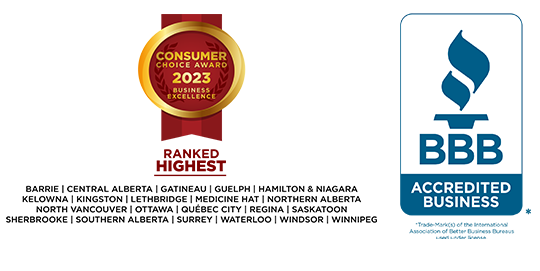The truth about tax debt
Owing Canada Revenue Agency (CRA) money can be overwhelming — especially because the government has greater powers to collect outstanding debts compared to other creditors.

The bad news is many of the rumours you may have heard are true: CRA can charge highly punitive penalties, withhold certain government benefits (e.g., child tax benefit, employment insurance, Canada Pension Plan, etc.) freeze your accounts, and garnish wages without a court order.
The good news is there are several ways to permanently overcome debts owing to CRA, including proceedings under the Bankruptcy and Insolvency Act (BIA) such as Bankruptcy and Consumer Proposal.
To follow is some information regarding your options for paying your tax debt, the powers of CRA to collect, and what to do when you simply cannot pay the debt owing.
Address the debt as soon as possible
So, you’ve just discovered you owe funds to CRA — take one of the following steps as soon as possible:
- Submit the full balance owing by the deadline set by Canada Revenue Agency.
- Make payment arrangements immediately if you know you cannot pay by the April 30 deadline.
For personal income tax debt, this deadline is April 30* of the following year (e.g., debts that surface in on your income taxes 2022 must be paid by April 30, 2023).
*Note: Although self-employed individuals do not have to file personal tax returns until June 15, outstanding taxes are still due by April 30.
If you cannot reach a mutually agreeable solution, consult a Licensed Insolvency Trustee as soon as possible to begin considering alternative options.
*Note: The current interest rate set by law at the time of writing is five percent annually (compounded daily), effective from January 1 to March 31, 2022.
What happens if you don’t pay?
CRA takes tax debt seriously. They have a large team and extensive resources at their disposal and will use a wide range of tactics to recover any outstanding taxes. Following is a general outline of what you can expect if you miss the April 30 payment deadline.
- Your case will be assigned to a CRA collections officer. You will receive calls from the collections officer who will try to arrange a payment plan with you.
- CRA may take legal action if you breach the payment arrangement or fail to pay the outstanding balance, which could result in serious consequences for you.
- Make one attempt to give verbal legal warning by phone
- Send one written legal warning letter
- CRA can issue a requirement to pay (RTP) to a third party that owes you money or is holding funds for you. This could be another individual, your employer (sometimes called a garnish), a bank, or other sources of funds.
- CRA can issue a set-off to redirect funds owed to you by any federal government department or agency towards your outstanding debt. CRA can use your federal income, GST / HST tax credits or any future income tax refunds to reduce your debt. CRA can issue a set-off even if you have made payment arrangements and are making payments.
- CRA can get a certificate confirming the amount you owe, which will make your debt a matter of public record and allow the CRA to proceed with asset liens and seizures. CRA will usually notify you by mail that your debt has been certified in Federal Court. The letter advises you that CRA may take further legal action to pay the debt if you do not resolve your account.
- Registering a lien on assets: Once the debt is certified, CRA can register a lien against your assets and property, including your personal residence. Registering a lien will secure the amount of debt owing by establishing creditor priority in the event of a sale.
If you sell your asset, your CRA tax debt will be paid from the proceeds of the sale before you receive any remaining proceeds. - Seizing and selling your assets: If your debt remains outstanding, CRA may get a writ or memorial to seize and sell your assets and property. This could include your car, boat, artwork, cottage, rental property, or personal residence.
- Your tax debt
- Any costs charged by the bailiff hired to sell the assets on behalf of the CRA
Before starting legal action*, CRA must:
*Note: CRA will normally not generally start legal action until 90 days after the mailing date of the notice of assessment or reassessment — nor will it typically withdraw legal action once it has started.
The RTP instructs the third party to redirect the funds — including up to 50 percent of your wages if you’re employed or 100 percent of your wages if you’re a subcontractor — to CRA. CRA will apply any funds received to your debt. CRA can send an RTP without a court order, in most cases through its authority under section 224 of the Income Tax Act or section 317 of the Excise Tax Act.
In some instances — such as in the case of debts that are at risk of not being collected (in jeopardy) — the CRA may advise you verbally that the debt has been certified in Federal Court.
If the CRA sells your assets, the proceeds will be used to pay:
You will still have to pay any remaining tax debt not covered by the proceeds of the asset sale.
Only a Licensed Insolvency Trustee can help when you cannot pay CRA debts
A Licensed Insolvency Trustee (LIT) is a federally regulated financial professional and is the only professional in Canada who is licensed and legally able to administer Bankruptcies and Consumer Proposals in Canada.
Bankruptcy and Consumer Proposals are legal proceedings under the BIA and are the only two debt solutions which can address debts owning to CRA. One of the most significant benefits of these solutions — aside from providing a clear and legally-binding path to debt relief — is a stay of proceedings. The stay of proceedings helps you in the following ways:
- Puts an immediate stop to all current collections action by all creditors, including CRA (e.g., phone calls / letters; garnishments / liens / set offs / asset seizures; etc.)
- Prevents creditors (including CRA) from initiating future collections action against you while the stay of proceedings is in place
- Prevents creditors from initiating legal action against you while the stay of proceedings is in place.
The stay of proceedings will remain in place until your debt is eliminated, provided you continue to fulfill your duties in a Bankruptcy or Consumer Proposal.
Schedule a Free Confidential Consultation to discuss your options
MNP offers a free, no-obligation initial assessment to all Canadian residents who are struggling with unmanageable debt. During this session, we will review your financial situation and budget, discuss your challenges and goals in depth, and discuss all the potential options to address your debt. You will ultimately make the decision on the path you take to a financial fresh start.
If you decide to pursue a Bankruptcy or Consumer Proposal:
- The Licensed Insolvency Trustee will collect some information and documentation from you and prepare the documents required to file a Bankruptcy or Consumer Proposal.
- You will then meet with the LIT to sign these documents.
- Once signed, the LIT will file your Bankruptcy or Consumer Proposal with the Office of the Superintendent of Bankruptcy (a department within the Federal Government) and your creditors.
- Once notified, the calls, collection activity, and any legal action will cease.
- From the filing date onward, your LIT will deal with your creditors regarding the debt you owe.
- Any debts that were included in the Bankruptcy or Consumer Proposal (including debts owing to CRA) will be forgiven at the end of your bankruptcy or proposal term, provided you successfully complete the proceeding.
- Put your financial problems behind you and enjoy your financial freedom.

